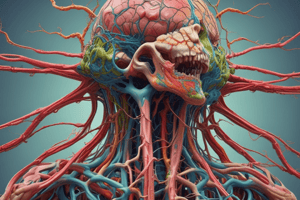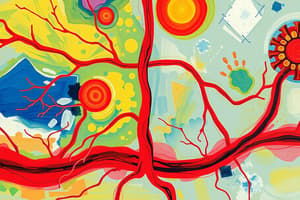Podcast
Questions and Answers
What does the lymphatic system consist of?
What does the lymphatic system consist of?
- Bones
- Cardiovascular veins
- Red blood cells
- Lymphatic vessels and organs (correct)
What are the four main functions of the lymphatic system?
What are the four main functions of the lymphatic system?
- Absorb excess interstitial fluid, 2. Absorb dietary fats, 3. Production, maintenance, and distribution of lymphocytes, 4. Fighting pathogens.
Which of the following statements is true about lymphatic vessels?
Which of the following statements is true about lymphatic vessels?
- They are similar in anatomy to cardiovascular veins. (correct)
- Movement of lymph does not depend on skeletal muscle.
- They carry oxygenated blood.
- They do not have valves.
What are the two lymphatic ducts?
What are the two lymphatic ducts?
What are the two types of lymphatic organs?
What are the two types of lymphatic organs?
What is the primary function of red bone marrow in the lymphatic system?
What is the primary function of red bone marrow in the lymphatic system?
The thymus is responsible for T cell maturation.
The thymus is responsible for T cell maturation.
What is the function of the spleen?
What is the function of the spleen?
Lymph nodes are commonly found in the _____, armpit, and groin.
Lymph nodes are commonly found in the _____, armpit, and groin.
Which of the following is true about tonsils?
Which of the following is true about tonsils?
What is immunity?
What is immunity?
Innate immunity has memory and specific recognition.
Innate immunity has memory and specific recognition.
What are non-specific defenses?
What are non-specific defenses?
What is considered the first line of defense in the immune system?
What is considered the first line of defense in the immune system?
What are the four hallmarks of the inflammatory response?
What are the four hallmarks of the inflammatory response?
What is the role of protective proteins in the immune system?
What is the role of protective proteins in the immune system?
What is adaptive immunity?
What is adaptive immunity?
How does the adaptive immune system work?
How does the adaptive immune system work?
What are B Cell Receptors (BCR)?
What are B Cell Receptors (BCR)?
What is the structure of an antibody?
What is the structure of an antibody?
Which immunoglobulin is the major type found in blood?
Which immunoglobulin is the major type found in blood?
IgM is the _____ antibody formed by newborns.
IgM is the _____ antibody formed by newborns.
What is the primary function of IgA?
What is the primary function of IgA?
IgE is responsible for immediate allergic responses.
IgE is responsible for immediate allergic responses.
What is one function of antibodies?
What is one function of antibodies?
Study Notes
Lymphatic System Overview
- Comprises lymphatic vessels and organs.
- Performs essential functions including absorbing excess interstitial fluid and dietary fats, producing lymphocytes, and fighting pathogens.
Lymphatic Vessels
- Similar to cardiovascular veins, featuring valves.
- Lymph movement is aided by skeletal muscle contractions.
Lymphatic Ducts
- Two primary ducts:
- Thoracic duct (larger), drains into the left subclavian vein.
- Right lymphatic duct (smaller), drains into the right subclavian vein.
Lymphatic Organs
- Two categories: primary organs (red bone marrow, thymus) and secondary organs (lymph nodes, spleen, tonsils).
Specific Lymphatic Organs
- Red Bone Marrow: Site for blood cell production and maturation of B cells.
- Thymus: Bilobed organ where immature T cells mature; produces Thymosin, which aids T cell maturation.
- Spleen: Filters blood, removes pathogens and old red blood cells via macrophages.
- Lymph Nodes: Located along lymphatic vessels, filter lymph, and are abundant in neck, armpit, and groin; contain compartments filled with immune cells.
- Tonsils: Located in the pharynx; function similarly to lymph nodes.
- Peyer Patches: Found in intestinal walls and appendices; contribute to immune defense.
Immunity
- Protection against foreign substances, pathogens, and cancer cells.
Innate Immunity
- Acts as the first responder without specific recognition; does not depend on prior pathogen exposure.
Nonspecific Defenses
- Include physical and chemical barriers, inflammatory response, and protective proteins.
Physical and Chemical Barriers
- First line of defense includes:
- Physical: Skin and mucous membranes.
- Chemical: Acidic secretions and enzymatic secretions.
Inflammatory Response
- The second line of defense involving neutrophils and macrophages.
- Classic symptoms include redness, heat, swelling, and pain, all triggered by histamine release.
Complement System
- A series of plasma proteins labeled by the letter C followed by numbers.
- Amplifies inflammatory response and assists in pathogen destruction.
Interferons
- Produced by virally infected cells to alert neighboring cells of viral presence.
Adaptive Immunity
- Activated upon pathogen exposure; provides protection against cancer.
- Relies on distinguishing "self" from "nonself" and functions through B cells and T cells.
Mechanisms of Adaptive Immunity
- Two pathways:
- Cell Mediated: T cell dependent.
- Antibody Mediated: B cell dependent (also known as humoral immunity).
B Cells and Antibody Mediated Immunity
- B cell receptors (BCR) bind to antigens, leading to proliferation into plasma and memory cells.
Antibody Structure
- Y-shaped proteins composed of variable (antigen binding site) and constant regions (classification).
Types of Antibodies
- IgG: Major antibody in blood; crosses placenta; activates complement and enhances phagocytosis.
- IgM: Largest antibody; first produced during infection; agglutinates cells.
- IgA: Predominantly found in secretions (saliva, breast milk); prevents pathogen attachment to epithelial cells.
- IgD: Found on immature B cells; indicates readiness for activation.
- IgE: Associated with allergic responses and parasitic worm protection.
Functions of Antibodies
- Include neutralizing pathogens and attracting white blood cells for enhanced immune response.
Studying That Suits You
Use AI to generate personalized quizzes and flashcards to suit your learning preferences.
Description
Test your knowledge of the lymphatic system with these flashcards covering key terms and functions. Learn about the anatomy, roles, and importance of lymphatic vessels and organs. Ideal for biology students looking to reinforce their understanding of this crucial system.




